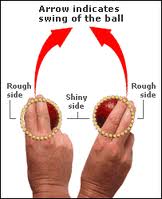
 |
| Index | ||||||
|
Swing, swerve, Away swing, In-swing, Out-swing  A cricket ball may or may not swing in the air during the course of a delivery It may be in-swing - swinging into the striker, or away-swing - swinging away from him, or what is called reverse or 'counter'-swing, when it does the opposite of what is expected Why a cricket ball swings has been the subject of intense debate and considerable scientific research, and it seems to have something to do with the combination of the bowler's action and how shiny or polished the ball is, especially if the shine or polish is only on one side. When a ball is fairly new and one side is kept polished with the other left to roughen during play, the ball will swing away from the shiny side. Swing can also be affected by the angle of the seam in relation to the direction of travel of the ball, the speed of the ball through the air and, sometimes, on the amount of spin on the ball. Some people believe that atmospheric conditions, particularly overcast, humid ones, will help the ball to swing, though there is no credible scientific evidence to support that claim The problem with that list is that the same bowler, using the same make of ball, on the same pitch with the same overhead conditions will be able to achieve prodigious swing one day and no swing at all on another. This is not as surprising as it might at first appear. There are always differences between one ball and another and, as the swing is largely determined by differences in the ball's surface texture, it would be surprising if different balls behaved in exactly the same way as each other Reverse or 'counter' swing has been much in the headlines in recent years, though whether it is a genuinely new phenomenon or has been in the game for decades without being labelled is an open question. If it happens at all, reverse swing usually occurs with an older ball. As the ball becomes worn with use and the 'shiny' side is also rough, a point may be reached where the ball does indeed swing towards the shiny side, contrary to 'normal' practice. This reverse swing can be enhanced or reduced by the position of the seam when the ball is being bowled Umpires have to be extra-vigilant when the ball is swinging - since, faced with appeals for LBW, they have to decide whether the swing would have taken the ball on to the stumps or sent it harmlessly past them. | ||||||